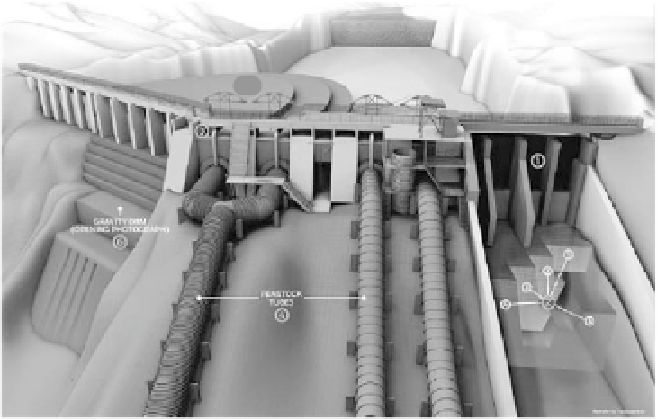Environmental Engineering Reference
In-Depth Information
Ļ
Ĺ
ķ
ļ
ĸ
ĺ
Fig. 7.31
Six phases of removal of the Elwha Dam
Phase 6 Remove the concrete gravity dam 2-3 m at a time using explosives and restore the natural river
channel in 2 months.
7.3.2.2
Dam Removal in Other Countries
Internationally, grassroots campaigns are calling for dam removal to restore rivers and promote the rights
of affected communities. Activists are targeting dams that continue to have significant negative social
and environmental impacts and fail to live up to economic promises (http://www.irn.org/revival/decom/
brochure/rrpt2.html, 2007).
France
—Inspired in part by decommissioning efforts on the Elwha River in the U.S., the SOS Loire
Vivante (Living Loire) network is working to remove old dams and restore France's only remaining river
that supports native salmon. In 1998, two dams on tributaries of the Upper Loire were demolished to
help protecting the last Loire salmon. First, the 12 m high Saint-Etienne-du-Vigan Dam on the Upper
Allier was removed, marking the first case in which France's state-owned electricity utility destroyed a
dam to restore the salmon habitat. The Vienne River, the second largest Loire tributary, also flows freely
now after demolition of the 4 m high Maisons-Rouges Dam. A dam in Kernansquillec on the Leguer River
was also dismantled, in 1996, after rapid sedimentation had reduced the reservoir capacity by 50%. Dam
removal in France and the Loire River management plan reflect growing awareness across Europe, where
concessions for thousands of dams built before 1950 are to be reviewed in the next decade.
Canada
—In Canada, there is also growing interest in decommissioning dams and river restoration.
Canada's regulatory regime differs from the U.S. system, especially in that dam licenses are issued in
perpetuity. Of the 2,000 dams in British Columbia, 400 have either outlived their usefulness, provide only
marginal benefits, or severely harm coastal fisheries. With the removal of nearly two dozen small dams
in the province, support is growing for more ambitious decommissioning proposals.
On British Columbia's Theodosia River, a plan to revitalize lucrative commercial and sport salmon
fisheries in the Georgia Straits is the basis for a plan to decommission a 35 year old water diversion dam.
If removed, the 8 m high, 125 m long, Theodosia Dam would be the largest dam ever dismantled in Canada.
Rather than dismantle the entire dam right away, stakeholders are pursuing other decommissioning options,
including water diversion reductions. Save the Theodosia Coalition has attracted 140,000 people to join
the coalition, they claimed that “No dam was meant to last forever- they do age and, eventually, outlive
their usefulness. When that occurs, we have to look at the decommissioning or dismantling option in








Search WWH ::

Custom Search